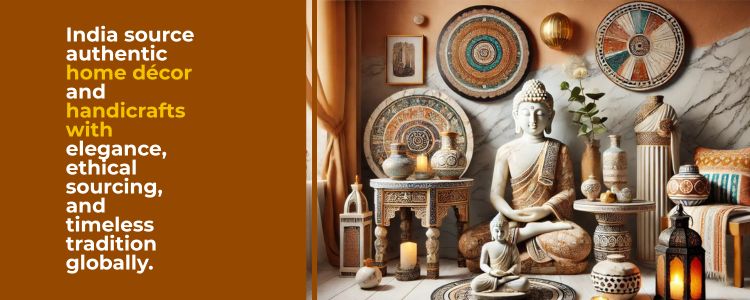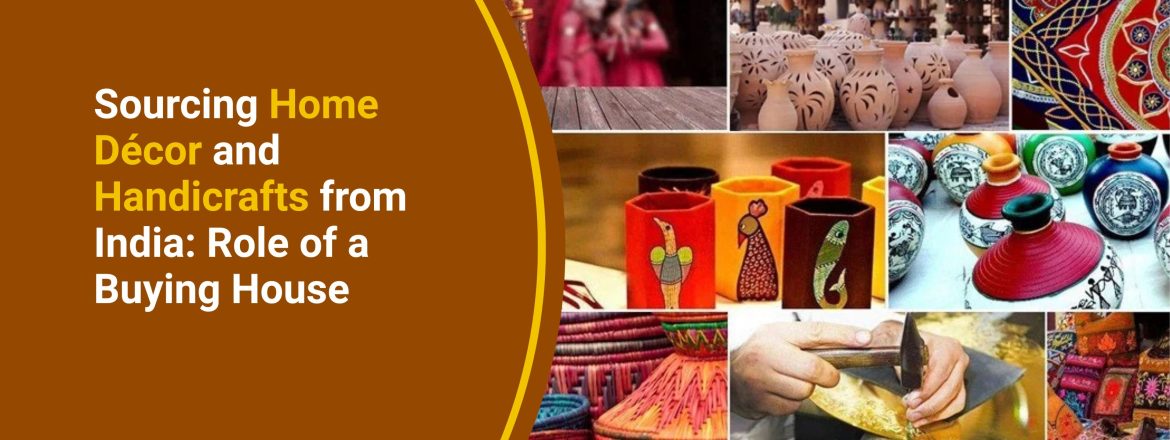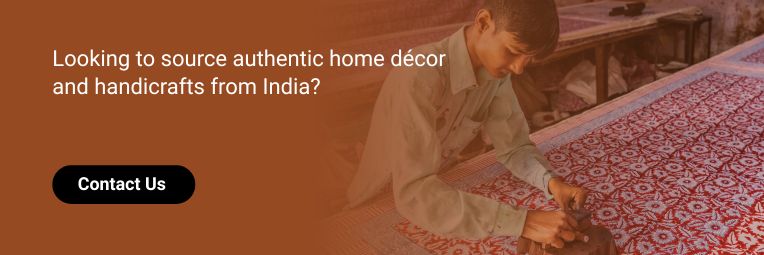Sourcing Home Décor and Handicrafts from India: Role of a Buying House
The Rise of Indian Handicrafts Export in Global Markets
The legacy of artisanal craftsmanship in India is not just cultural and it is not just local, national, or even global. It is now becoming an essential part of sustainable trade. Whether it is intricately carved wooden items or hand-woven saris, the Indian Handicrafts Export industry has gained immense traction in international markets in the past two decades. To put the size and scope of the industry into perspective, industry estimates suggest there are more than 7 million artisans working in the industry, most of which are women or rural workers. Where the handicrafts industry reflects an exciting convergence of tradition, skill, and the potential for employing millions of people in India or elsewhere.
In a world wading through and demanding uniqueness and authenticity, buyers are increasingly turning to India and the country’s unique aesthetic and ethical appeal with hand made handicrafts. The data from the last number of years show that home décor, and artisanal items from India are becoming first prize considerations for importers from the US, UK, and European Union for example. A lot of this growth and demand can be attributed to the vital, if somewhat silent role of a buying house, which regularly engages as a professional intermediary, ensuring quality, conformity and punctual delivery.
Why a Global Sourcing Company Needs a Local Buying House
For any global sourcing company of note venturing into the craft sectors in India, going in without an agent who knows the ground is like trying to walk through a maze blindfolded. India’s strength is in its diversity; but diversity comes with additional supply fragmentation, language barriers, and logistics challenges. Buying houses provide the necessary scaffolding for accessing Indian craft industries.
They function as an extension of the international buyer from regional bases in Moradabad (metalware), Jaipur (blue pottery, block prints), Saharanpur (woodwork), Narsapur (crochet lace, etc.) to manage their vendor engagements, compliance audits, and sample development. A reputable buying house has the knowledge and expertise to match all the artisanal potential with commercial demand; therefore, they are an essential partner for any global sourcing companies who want to ensure long-term sustainability.
Moreover, in many cases these firms also play a part in facilitating Ethical Sourcing of Indian Home Accessories by being able to confirm no child labour, fair wage practices, and sustainable production practices.

Curating Handmade Handicrafts Items: A Layered Process
Sourcing handmade handicrafts from India is not limited to just negotiating prices or browsing through catalogues. This is a layered and usually iterative process, from map trends, assess raw materials, prototype approvals, and scalability. Buying houses not only filter the best artisans for each product type, they help ensure quality control in each phase.
For example, a rustic wooden lantern sourced from a workshop in Saharanpur may involve wood carvers, metal fitters, and polishers—usually in different villages. This is where buying houses demonstrate their value.
Further, they provide market intelligence to help tailor Indian home items to the taste of overseas buyers; from color palettes that suit Scandinavian minimalism to the Afro-boho aesthetic currently in vogue in Western interiors.
Navigating the Spectrum of Indian Home Décor Products
The category of Indian Home Décor Products ( No-follow ) encompasses everything from tribal wall hangings to contemporary sustainable bamboo planters. The strength of Indian artisans comes not just from creativity, but also from their ability to customize. Their approach to small-batch production benefits buyers’ SKU specifications.
Due to the breadth of this category, buying houses often take a full-service approach, developing seasonal collections, working through design input with buyers, and managing international compliance guidelines such as REACH and CPSIA. Full-service engagement is especially relevant today, since post-pandemic travel restrictions and quality issues magnified the need for local sourcing expertise.
Buyers seeking Wholesale Indian Handicrafts for Export often utilize these types of agencies for almost everything other than procurement—vendor audits, lab testing, packaging compliance—functions that become very difficult to monitor from abroad.
Enhancing Indian Handicrafts Export through Strategic Partnerships
Indian Handicrafts items is beginning to move away from transactional supply chains and towards meaningful partnerships. Our survey data suggests that UK and EU buyers are actively seeking to work with Indian artisans to co-create collections (with buying houses and associated design cells and, in some cases, in-house quality teams supporting the process).
At the macro level, this further aligns with the global movement towards conscious consumption. To that point, India is increasingly being positioned in wider international dialogues regarding Global Supply Chain Sustainability, signifying demand for crafts that can be scaled while aligning to sustainability. The cultural capital of craftsmanship in India, combined with structured sourcing approaches, makes a compelling case for export.
The Future for Any Global Sourcing Company Investing in India
In an environment in which geopolitical positioning and supply chains are shifting, India is increasingly emerging as the go-to non-China sourcing destination. For any global sourcing company looking to future-proof their portfolio, India has unmatched breadth in the home items space.
This would even be more so for companies who are focusing on differentiation of products, ethical (or narrative) sourcing and flexibility of order size. As buying houses scale up their digital capabilities and compliance requirements, they should see more strategic value in doing so, allowing them to play a pivotal role in translating India’s artisanal heritage into the mechanics of a global business opportunity.
Final Thoughts: Strengthening Indian Home Décor Products Pipeline
The sourcing of Indian Home Décor Items is no longer a niche activity–it is woven into the broader discussion of identity, ethics, and global commerce. There is a formal wholesale supply side steeped in tradition, and a rapidly modernizing demand side. Purchasing houses are the important link between these two sides; they act as authenticators for artisan voices while meeting the demands of vast global buyers.
For importers contemplating how to source handicrafts in India, working with an established buying house is not merely a recommendation–it is a necessity. A buying house will serve as the party to answer any questions relating to trade documentation or establishing expectations for SKU quality for example within Sourcing Home Décor products from India.
As newer markets start to test Indian craftsmanship and UK-Based Sustainable Sourcing Companies start to add Indian SKU’s to their catalogue, the crossroads of art and professionalism will be the next chapter in India’s journey in global sourcing.









